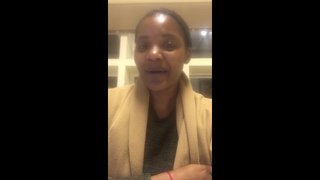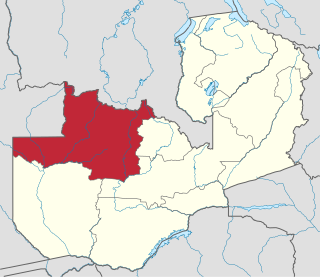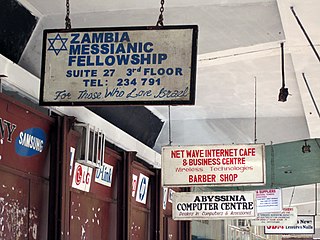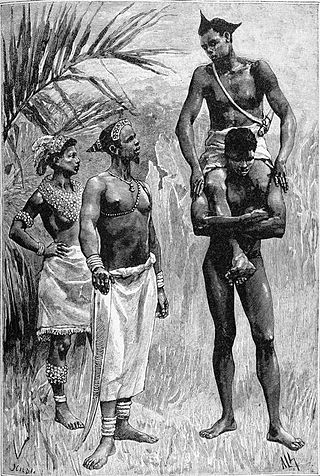Related Research Articles

Zambia, officially the Republic of Zambia, is a landlocked country at the crossroads of Central, Southern and East Africa. It is typically referred to being in South-Central Africa and is culturally Southern African. Its neighbours are the Democratic Republic of the Congo to the north, Tanzania to the north-east, Malawi to the east, Mozambique to the southeast, Zimbabwe and Botswana to the south, Namibia to the southwest, and Angola to the west. The capital city of Zambia is Lusaka, located in the south-central part of Zambia. The population is concentrated mainly around Lusaka in the south and the Copperbelt Province to the north, the core economic hubs of the country.

The Bemba language, ChiBemba, is a Bantu language spoken primarily in north-eastern Zambia by the Bemba people and as a lingua franca by about 18 related ethnic groups.
Kaonde (kiiKaonde) is a Bantu language spoken primarily in Zambia but also in the Democratic Republic of the Congo. Kaonde and its dialects are spoken and understood by perhaps 350,000 people or more. It is estimated that approximately 2.3% of Zambians are native Kaonde speakers. Kaonde speakers overwhelmingly live in the Northwestern and parts of Central regions of Zambia.

Lozi, also known as siLozi and Rozi, is a Bantu language of the Niger–Congo language family within the Sotho–Tswana branch of Zone S (S.30), that is spoken by the Lozi people, primarily in southwestern Zambia and in surrounding countries. This language is most closely related to Northern Sotho, Tswana (Setswana), Kgalagari (SheKgalagari) and Sotho. Lozi, sometimes written as Rotse, and its dialects are spoken and understood by approximately six per cent of the population of Zambia. Silozi is the endonym as defined by the United Nations. Lozi is the exonym.
Lunda, also known as Chilunda, is a Bantu language spoken in Zambia, Angola, and, to a lesser extent, in the Democratic Republic of the Congo (DRC). Lunda and its dialects are spoken and understood by perhaps 4.6% of Zambians, and the language is used mainly in the Northwestern province of Zambia. The majority of the Lunda can be found in DRC, especially Katanga Province, as well as in Angola. A small number of Lunda dialects are represented in Namibia.
Sanford Berman is a librarian. He is known for radicalism, promoting alternative viewpoints in librarianship, and acting as a proactive information conduit to other librarians around the world. His vehicles of influence include public speaking, voluminous correspondence, and unsolicited "care packages" delivered via the U.S. Postal Service. Will Manley, columnist for the American Library Association (ALA) publication, American Libraries, has praised Berman: "He makes you proud to be a librarian."
Solwezi is a town in Zambia. It is the provincial capital of the mineral-rich North-Western Province. Solwezi is also the administrative capital of Solwezi District, one of the eleven districts in the North-Western Province.

The Miombo woodland is a tropical and subtropical grasslands, savannas, and shrublands biome located primarily in Central Africa. It includes four woodland savanna ecoregions characterized by the dominant presence of Brachystegia and Julbernardia species of trees, and has a range of climates ranging from humid to semi-arid, and tropical to subtropical or even temperate. The trees characteristically shed their leaves for a short period in the dry season to reduce water loss and produce a flush of new leaves just before the onset of the wet season with rich gold and red colours masking the underlying chlorophyll, reminiscent of autumn colours in the temperate zone.

Ndola is the third largest city in Zambia and third in terms of size and population, with a population of 475,194, after the capital, Lusaka, and Kitwe, and the second largest in terms of infrastructure development after Lusaka. It is the industrial and commercial center of the Copperbelt, Zambia's copper-mining region, and capital of Copperbelt Province. It lies just 10 kilometres (6.2 mi) from the border with DR Congo. It is also home to Zambia's first modern stadium, the Levy Mwanawasa Stadium.

Chavuma is a town in the North-Western Province of Zambia, lying immediately south of the border with Angola. The town is approximately 1,100 kilometers from Lusaka and 11 kilometers from the Angolan border town of Kalipande. It lies on the Zambezi River. Local attractions include the Chavuma Falls, while a market takes place on the border, permitting people from both nations to trade.
Tonga (Chitonga), also known as Zambezi, is a Bantu language primarily spoken by the Tonga people (Batonga) who live mainly in the Southern province, Lusaka province, Central Province and Western province of Zambia, and in northern Zimbabwe, with a few in Mozambique. The language is also spoken by the Iwe, Toka and Leya people, and perhaps by the Kafwe Twa, as well as many bilingual Zambians and Zimbabweans. In Zambia Tonga is taught in schools as first language in the whole of Southern Province, Lusaka and Central Provinces.

North-Western Province is one of ten Provinces of Zambia. It covers an area of 125,826 km2 (48,582 sq mi), has a population of 727,044 and a population density of 5.80 per square kilometre as of 2010. It is the most sparsely populated province in the country. The provincial capital is Solwezi. The literacy rate stood at 63 per cent against a national average of 70.2 per cent. The rural population constituted 77.45%, while the urban population was 22.55%. North-Western Province is bordered along Angola in the west, the Democratic Republic of Congo in the north, Copperbelt Province in the east, Central in the south-east, and Western Province in the south-west.

Zambia has several major indigenous languages, all members of the Bantu family, as well as Khwedam, Zambian Sign Language, several immigrant languages and the pidgins Settla and Fanagalo. English is the official language and the major language of business and education.

The Lunda are a Bantu ethnic group that originated in what is now the Democratic Republic of the Congo along the Kalanyi River and formed the Kingdom of Lunda in the 17th century under their ruler, Mwata Yamvo or Mwaant Yav, with their capital at Musumba. From there they spread widely through Katanga and into Eastern Angola, north-western Zambia and the Luapula valley of Zambia.
The Luvale people, also spelled Lovale, Balovale, Lubale, as well as Lwena or Luena in Angola, are a Bantu ethnic group found in northwestern Zambia and southeastern Angola. They are closely related to the Lunda and Ndembu to the northeast, but they also share cultural similarities to the Kaonde to the east, and to the Chokwe and Luchazi, important groups of eastern Angola.
The Twa of the Lukanga Swamp of Zambia are one of several fishing and hunter-gatherer castes living in a patron–client relationship with farming Bantu peoples across central and southern Africa. The Lukanga Twa live primarily among the Lenje, and speak the Lenje language.
Lenje is a Bantu language of central Zambia. The Lukanga dialect is spoken by the Lukanga Twa Pygmies, fishermen of the Lukanga Swamp. Alternate names for the language are Chilenje, Chinamukuni, Ciina, Ciina Mukuni, Lengi, Lenji, and Mukuni.
Ila (Chiila) is a language of Zambia. Maho (2009) lists Lundwe (Shukulumbwe) and Sala as distinct languages most closely related to Ila. Ila is one of the languages of the Earth included on the Voyager Golden Record.
The Vambunda or Vampunda are a Bantu people who, during the Bantu migrations, came from the north to south-eastern Angola and finally Barotseland, now part of Zambia. Their core is at present found in the south-east of Angola from the Lunguevungu river in Moxico to the Cuando Cubango Province.
Mwene Chitengi Chiyengele was a Mbunda king who led his people from south-eastern Angola to Barotseland in western Zambia around 1824. The Mbunda were skilled game hunters and fighters using bow and arrow. They were welcomed by King Mulambwa of the Aluyi of Barotseland, now Western Zambia.
References
- ↑ Luvale at Ethnologue (18th ed., 2015) (subscription required)
- ↑ Jouni Filip Maho, 2009. New Updated Guthrie List Online
- ↑ "Luvale (Chiluvale)". Omniglot. Retrieved 23 May 2022.
- ↑ Albaugh, Ericka A.; de Luna, Kathryn M. (2018). Tracing language movement in Africa. New York, NY: Oxford University Press. pp. 263, 267, 269, 271. ISBN 9780190657550.
- 1 2 Moran, Steven; McCloy, Daniel. "Inventory Luvale (SPA 146)". PHOIBLE 2.0. Retrieved 29 May 2022.